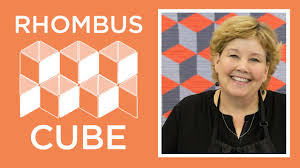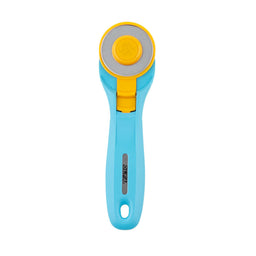Rhombus Cube Quilt Tutorial
Jenny Doan
Rhombus Cube Quilt Tutorial
- 2 yards x Coral Fabric
- 2 yards x Light Grey Fabric
- 2 yards x Dark Gray Fabric
- 1-1/2 yards x Black Fabric
- 5 yards x Backing Fabric

Finish your masterpiece and let us give it the finishing touch it deserves.
Subscribe to MSQC on YouTube
Hundreds of FREE tutorials and a new one from Jenny launches every Friday.
video transcript
Jenny shows us how to make a 3-D Rhombus Cube Quilt without a Y-seam using yardage of Cotton Couture by Michael Miller and the MSQC Rhombus Template.
Hi everybody, it’s Jenny from the MSQC. And I am so excited about today’s project. This is one of the mysteries of the quilt world, how to create these tumbling block quilts without the Y seam. So we’ve got a fun tutorial for you today. So to make this quilt what you’re going to need is two yards of a light, a medium and a dark. We’ve used Cotton Couture by Michael Miller and we’ve used the light gray, the dark gray, the coral color. And then for this outer border out here, that’s our black and it just sets it so it makes it look like the quilt is just floating on there. It’s just a great look. And you need a yard and a half for that border. So two yards of all your other fabrics and a yard and a half for your outer border and that’s just going to set it off. You’re also going to need this rhombus template. And this is just a great little template and I just can hardly wait to show you how to do this. So let’s get started.
The first thing you’re going to do is you’re going to cut your fabric into five inch strips. And I’ve got some five inch strips cut here. I’ve got my coral. I’ve got a dark gray and I’ve got my light gray. The light, medium and dark is really important on this because you want it to look like the sun’s coming in. You want to be able to see this block right here that it has dimension and it pops and it forms that tumbling block shape. And so the light, medium and dark is really important. So when you’re ready to cut your rhombuses, you’re going to open up your fabric like this. If you leave it together in a, folded which I do sometimes, you won’t get as many out of them. You should be able to get ten per strip, ten of these because you’re going to cut them two. Now when you lay them, let me move this so you can see it. When you lay them on here you can see that this rhombus just goes edge to edge right here. It takes up every bit of that strip and it just fits right on there. It might work better if I show you with this dark gray. Let me put this dark gray in here. My mat is the same color as the fabric so it’s a little bit hard to see. So we’re going to put this right here. And see these little notches right here too. We’re going to go ahead and cut those notches. And so when you’re ready to cut this, I’m just cutting my little notch right here and then I’m cutting it up here like this. This should slide away. I’m going to whip this around and then we’re going to go ahead and cut the notch over here and then trim this up. This is the shape you’re looking for right here. So you’re going to cut all of your strips into dark grays and light grays like this. So I have a little stack of these right here already done. These two right here.
Next you’re going to need to cut your triangles. These are your coral triangles. And let me show you how to do that. This, the rhombus template is very well marked for this which, which I love. So right here it says “Use this side for triangles” so helpful. And then it says “Line up this edge of the fabric, line up this line with the edge of the fabric” So you can see that is comes kind of on the other side of the triangle right here. But we’re going to go ahead and line that up on that edge. And we’re going to go ahead and cut this out. Again don’t forget your notches. Try not to go in too far with those notches because your next triangle is going to come out on the flip side of that. So we’re going to go ahead here and cut these. And you’re going to get a stack of these really quick because I left mine in fours. So then of course you’re just going to turn this around and come over here and cut your next set. And you’re going to do that to all your coral as well.
So now we are ready to assemble our rows. And an easy way to do that, a little quicker, is you’re going to take your dark gray and your light gray and they each get a triangle attached to it but you can see these are going different directions. So you want to make sure that all your gray ones are going the same way, I mean your dark grays are going the same way and your light grays. When you’re ready to put your triangle on the edge here, we’re going to take this, and you know I’m a little angley challenged so I really use the diagram on this quilt so I make sure this is going the same direction. And then I’m going to attach my triangle to this side right here. Now this is 60 degree triangles, so you know any side you attach it to it’s going to work. But you just need to make sure it is attached to the right side. So you lay these right side together and the little notches will line it up exactly. So let’s go to the sewing machine and sew one of these on. We’re going to do it a quarter of an inch and they just line up exactly. And we’re just going to sew down here. There we go. And you’re going to do this to all your dark grays. And they’re going to go one direction. And your light grays are going to go another direction. So let’s go ahead and press this back.
Alright. So you’re going to kind of have a stack of these going so that you’re ready to put them together and then we’re ready to assemble the rows. Now the diagram is going to be super helpful to you when you’re ready to assemble the rows. So for instance, let me show you this. You have two different rows here. Your first row here, and you’ll notice right here, see this black one. You attach a black one first to your coral triangle. And that’s going to be trimmed off for the edge of your border so that it, you know it’s just easy to, easier to attach the whole triangle and just trim that off. But go ahead and put your whole triangle on. And then I want to show you where this fits. So right here. See here is your row right here. Can you see that? And so you’ve got this light gray has to be opposite the dark gray. So you’re going to make this row like this. And you’re going to, you’re going to assemble it vertically. That’s what eliminates the Y seam so it makes it really easy. So then your next row you’re going to sew with your, your gray ones. So here you see the first one here. You have your coral triangle and then the light gray, coral triangle, dark gray. When you do your next row, it’s going to be just the opposite. Coral triangle, dark gray, coral triangle, light gray. So just follow the diagram because that will save you.
When you’re ready to put these together they’re going to go together just like this. And see you’ve, you can already see we’re going to lose this line right here between these triangles so that you can see the blocks right here. Here’s our box. So we’re going to go ahead and sew these two rows together so you can see how that looks. So I’m going to fold it over here. As you’re sewing you just want to match up your edges for your corals and where the other pieces come together right here. You know where your lights and dark grays come together. Just match them up and you’ll be able to do that quarter of an inch. So I’m going to sew down this row a little bit so you can see it. Because this, this is so cool. I have loved this block for a long time. But you know I’m always looking for that easier way and this is an easier way. But you are going to want to follow that diagram. Alright here we go. We’re sewing a quarter of an inch down the side. As I’m sewing along I’m making sure that where my colors come together that they are matched, lined right up together. So I stop and I look at my two corals to make sure they’re right on top of each other. And of course I don’t have two, these aren’t full strips down here because I just want to show you how to do this. But you’re going to sew full strips together. We’re going to go iron these open and see how we did matching up all these little junctions. So let’s see here. Set your seam. And then I’m just going to roll this back. Oh my gosh, this is so much fun. So a template is awesome if it does one thing but if you can do a lot of things with that template it becomes valuable. And this is one of those templates I can see a lot of ideas happening. So we’ve got this together. You can see they line up really good, here’s our box. We’ve got our light, medium and dark right here. And I’m going to show you how this fits into the quilt. So we’re going to put this up here. Let’s see, here we go. There you go. See how this just fits right into the quilt right there. And so you’re just going to be something start over here. The first row is going to be a light, then a dark, then a light and a dark and so on. And you’re going to put those together.
So let’s see how many rows we have here. We have one, two, three, four, five, six, seven, eight, nine, ten, eleven, twelve, thirteen, fourteen, fifteen, sixteen rows across. That’s going to give you a quilt that’s 80 by 80. So it’s a pretty good size quilt. I love how putting it on the black just makes the whole quilt pop. I mean it just looks like it’s floating on there. And I love that look. So I hope you give this rhombus a try. I think it’s really cool. It’s a great idea. A lot of fun to try new things. So we hope you enjoyed this tutorial on the Rhombus Quilt from the MSQC.
& Progress on Social




